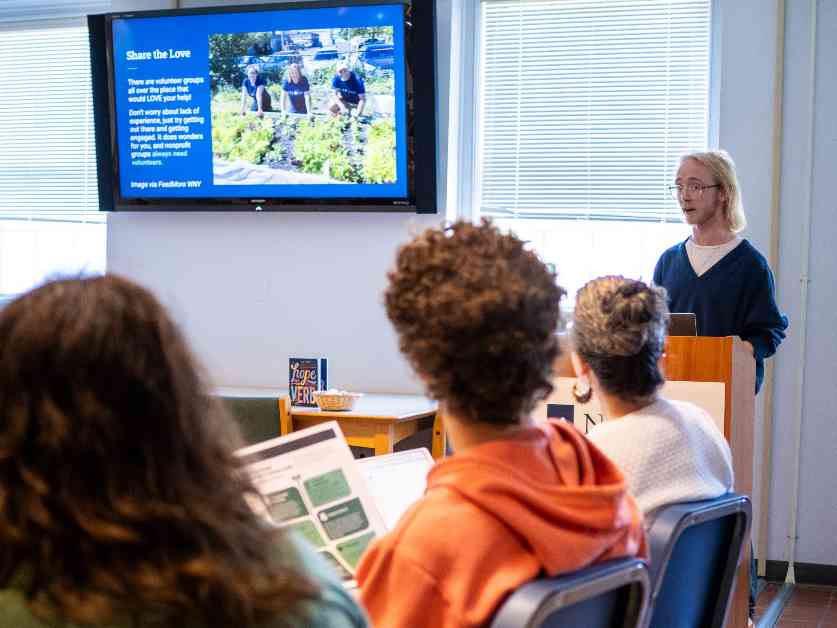Efforts of Colleges to Combat Climate Change: A Comprehensive Overview
Students in Andrea Varga’s honors Ethical Fashion class at SUNY New Paltz are actively engaged in presenting their ideas for reducing the climate consequences of the fashion industry. This initiative showcases the commitment of colleges to combat climate change and integrate sustainability practices into various academic disciplines.
Campus as a Living Lab Approach
The concept of the “campus as a living lab” is gaining traction in higher education institutions across the country. This approach involves blending classroom instruction with real-world projects aimed at decarbonizing campuses. For example, engineering students may retrofit campus buildings to improve energy efficiency, while students in a human behavior class may work on reducing food waste in cafeterias.
At the State University of New York, the living lab model is being implemented to encourage students to develop innovative solutions for sustainability on campus. From researching solar energy to composting, students are gaining practical skills in project management and finance as they work on green initiatives. The availability of funds from a university “green revolving fund” provides students with the opportunity to see their projects come to fruition, making the lessons learned more impactful.
Integration of Climate Education Across Disciplines
Anya Kamenetz, a former NPR education reporter, highlights a growing trend in colleges embedding climate-related content into various academic disciplines. Professors in fields ranging from theater to economics are incorporating climate-focused topics into their courses, ensuring that students from diverse majors are equipped with a foundational understanding of climate issues.
Toddi Steelman, vice president and vice provost for climate and sustainability at Duke University, emphasizes the importance of making every major a “climate major.” By integrating climate education into all disciplines, colleges prepare students to address climate challenges in their future careers, whether they become preachers, teachers, nurses, engineers, or legislators.
Strategies for Climate Action in Higher Education
Planet Ed, an Aspen Institute initiative on climate and education, outlines key strategies for colleges and universities to respond effectively to the climate crisis. These strategies encompass educating and supporting students, engaging communities, developing climate mitigation solutions, and prioritizing equity in climate work.
Higher education institutions play a crucial role in educating students on climate literacy and preparing them for careers in renewable energy and related fields. For example, the Kern Community College system in California is shifting its focus from training students for oil jobs to preparing them for roles in carbon management, aligning with sustainability goals.
Colleges are also engaging with communities to develop climate plans and address environmental challenges. Initiatives like the Bullard Center for Environmental and Climate Justice at Texas Southern University work closely with marginalized communities to mitigate environmental harms and promote sustainability.
Moreover, colleges are taking proactive steps to reduce their own carbon footprint and prepare for climate risks on campus. Arizona State University’s “campus metabolism dashboard” allows students and staff to monitor resource use, while Ringling College of Art and Design in Florida has transitioned 85% of its campus vehicles to electric, demonstrating a commitment to sustainable practices.
Equity is a central focus in climate action efforts, with colleges prioritizing support for students most affected by climate and educational inequities. The HBCU Climate Change Consortium aims to diversify the pipeline of environmental leaders by involving historically Black colleges and universities and tribal colleges in climate planning.
Interview with John B. King Jr., Chancellor of SUNY
In an interview with John B. King Jr., chancellor of the State University of New York and co-chair of This is Planet Ed, he discusses SUNY’s initiatives to combat climate change and promote sustainability on campuses. Naming a chief sustainability officer and convening a task force to develop a system-wide climate action plan are among the key steps taken by SUNY to address sustainability practices and educate students on climate issues.
While progress towards carbon neutrality is essential, challenges related to capital investment present obstacles for universities aiming to reduce their carbon footprint. SUNY and other institutions are exploring ways to make buildings more energy-efficient, transition to electric fleets, and implement sustainable practices without burdening students with additional costs.
The Impact of Climate Change on Childhood
Climate change is already reshaping childhood experiences, with extreme weather events disrupting schools and impacting student learning. High temperatures and environmental hazards pose challenges for children’s health and well-being, highlighting the urgent need for climate action.
Educators are increasingly incorporating climate education into K-12 curricula to empower students to be part of the solution. By engaging students in sustainability initiatives and promoting environmental awareness, schools can equip the next generation with the knowledge and skills needed to address climate challenges.
Conclusion
Efforts to combat climate change in colleges and universities are multifaceted, encompassing education, community engagement, sustainability practices, and equity initiatives. By integrating climate education across disciplines, fostering collaboration with communities, and prioritizing sustainability on campus, higher education institutions play a vital role in addressing the climate crisis.
As colleges continue to innovate and implement sustainable practices, the next generation of leaders will be equipped with the knowledge and skills to drive meaningful change in the fight against climate change. Through collaborative efforts and a commitment to environmental stewardship, colleges can lead by example and inspire students to become agents of positive change in a rapidly evolving world.


